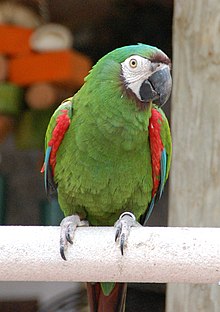Chestnut-fronted macaw
| Chestnut-fronted macaw | |
|---|---|

| |
| At Southwick's Zoo, Massachusetts, USA | |
| Scientific classification | |
| Kingdom: | Animalia |
| Phylum: | Chordata |
| Class: | Aves |
| Order: | Psittaciformes |
| Family: | Psittacidae |
| Genus: | Ara |
| Species: | A. severus
|
| Binomial name | |
| Ara severus | |
| Subspecies | |
| |

| |
| Synonyms | |
|
Psittacus severus Linnaeus, 1758 | |
The chestnut-fronted macaw or severe macaw (Ara severus) is one of the largest of the mini-macaws. It reaches a size of around 45 cm (18 in) of which around half is the length of the tail.
They can be found over a large part of Northern South America from Panama south into Amazonian Brazil and central Bolivia. A feral population is found in Florida.
Their lifespan is listed as anything from 30 to 80 years of age.[citation needed]
Description[]

The chestnut-fronted or severe macaw is mostly green in colour with patches of red and blue on the wings. The head has a chestnut brown patch just above the beak. The beak is black and the patches around the eyes are white with lines of small black feathers. It is the only one of the miniature macaws that has lines of feathers in the bare patches around its eyes. In the wild their typically gregarious personality can become more aggressive at puberty giving them the name Severe. This tendency can be curbed in captivity but the species requires significant handling to make a tame pet. It is 45–50 cm (17.5–19.5 in) long and weighs 300–410 g (11–14 oz).
Breeding[]


The chestnut-fronted macaw nest in a hole in a tree. The eggs are white and there are usually two or three in a clutch. The female incubates the eggs for about 28 days, and the chicks fledge from the nest about 70 days after hatching.[2]
References[]
- ^ BirdLife International (2018). "Ara severus". IUCN Red List of Threatened Species. 2018: e.T22685577A130103061. doi:10.2305/IUCN.UK.2018-2.RLTS.T22685577A130103061.en. Retrieved 12 November 2021.
- ^ Alderton, David (2003). The Ultimate Encyclopedia of Caged and Aviary Birds. London, England: Hermes House. p. 236. ISBN 1-84309-164-X.
External links[]
- Severe Macaw at Animal-World
- Chestnut-fronted Macaw photo gallery at Visual Resources for Ornithology
- Chestnut-fronted Macaw videos in the Internet Bird Collection
- Stamps (for Bolivia, Ecuador, Guyana, Panama, Peru, Suriname) with (inaccurate)-RangeMap
- Chestnut-fronted Macaw - Wild Perched Pair (medium res photo) and Article - "Amazonia Lodge" at Pinkmoose Birding
- Chestnut-fronted Macaw (high res photo) at Bird Watcher's Digest
- Chestnut-fronted Macaw (Ara severus) - Species Factsheet at BirdLife International
| Wikimedia Commons has media related to Ara severus. |
- IUCN Red List least concern species
- Ara (genus)
- Macaws
- Birds of Colombia
- Birds of Venezuela
- Birds of Ecuador
- Birds of the Amazon Basin
- Birds of the Guianas
- Birds described in 1758
- Taxa named by Carl Linnaeus
- Birds of Brazil
